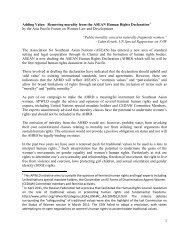A Digest of Case Law on the Human Rights of Women - Asia Pacific ...
A Digest of Case Law on the Human Rights of Women - Asia Pacific ...
A Digest of Case Law on the Human Rights of Women - Asia Pacific ...
Create successful ePaper yourself
Turn your PDF publications into a flip-book with our unique Google optimized e-Paper software.
Nurhatina Hasibuan v Pt. Ind<strong>on</strong>esia Toray Syn<strong>the</strong>tics, etc. (Ind<strong>on</strong>esia)<br />
Ms Hasibuan argued that Article 12, Figure 2 <str<strong>on</strong>g>of</str<strong>on</strong>g> <strong>the</strong> Mutual Working Agreement<br />
1954 [“<strong>the</strong> Working Agreement”] was discriminatory as it set a lower retirement age<br />
for women than for men. She argued it breached Article 2 <str<strong>on</strong>g>of</str<strong>on</strong>g> <strong>the</strong> Labour Act 1969,<br />
which states that employers should not discriminate <strong>on</strong> <strong>the</strong> basis <str<strong>on</strong>g>of</str<strong>on</strong>g> sex. Fur<strong>the</strong>r, she<br />
argued that <strong>the</strong> Labour Uni<strong>on</strong>, by knowingly agreeing to <strong>the</strong> Working Agreement,<br />
had also breached <strong>the</strong> Labour Act 1969. Finally, Ms Hasibuan argued that Ind<strong>on</strong>esia<br />
had internati<strong>on</strong>al obligati<strong>on</strong>s to promote <strong>the</strong> equality <str<strong>on</strong>g>of</str<strong>on</strong>g> women under CEDAW, and<br />
should <strong>the</strong>refore amend <strong>the</strong> Working Agreement to make equal provisi<strong>on</strong> for men<br />
and women.<br />
The resp<strong>on</strong>dents argued that <strong>the</strong> Court did not have jurisdicti<strong>on</strong> to decide this matter<br />
and that it should be handled by <strong>the</strong> administrative bodies resp<strong>on</strong>sible for solving<br />
labour disputes. These administrative bodies, <strong>the</strong> resp<strong>on</strong>dents argued, included <strong>the</strong><br />
Head Office <str<strong>on</strong>g>of</str<strong>on</strong>g> <strong>the</strong> Labour Ministry, as well as <strong>the</strong> Director General <str<strong>on</strong>g>of</str<strong>on</strong>g> Developing<br />
Labour Relati<strong>on</strong>ships and Job Norm Supervisi<strong>on</strong>. As <strong>the</strong>se were <strong>the</strong> bodies<br />
resp<strong>on</strong>sible for <strong>the</strong> Working Agreement any acti<strong>on</strong> should be directed at <strong>the</strong>m.<br />
The resp<strong>on</strong>dents also argued that even if <strong>the</strong> Court was found to have jurisdicti<strong>on</strong>,<br />
<strong>the</strong> different mandatory retirement age for men and women was part <str<strong>on</strong>g>of</str<strong>on</strong>g> a labour<br />
agreement that was <strong>on</strong>ly temporary (for two years) and <strong>on</strong> this basis should not be<br />
subjected to challenge for discriminati<strong>on</strong>.<br />
The resp<strong>on</strong>dents also argued that even if <strong>the</strong> Working Agreement was discriminatory,<br />
it was acceptable discriminati<strong>on</strong>. They argued that <strong>the</strong> biological difference between<br />
men and women justified a lower age <str<strong>on</strong>g>of</str<strong>on</strong>g> retirement for women. <strong>Women</strong>, for example,<br />
were more likely to experience work related stress and illness. The resp<strong>on</strong>dents<br />
argued that <strong>the</strong> purpose <str<strong>on</strong>g>of</str<strong>on</strong>g> <strong>the</strong> provisi<strong>on</strong> was protective, similar to legislati<strong>on</strong><br />
that prohibits women from working in mines, or at night. Fur<strong>the</strong>r, differences in<br />
retirement ages could also be found in o<strong>the</strong>r groups <str<strong>on</strong>g>of</str<strong>on</strong>g> employees in <strong>the</strong> workforce<br />
such as government positi<strong>on</strong>s where workers had a lower retirement age. This, <strong>the</strong><br />
resp<strong>on</strong>dents argued, was allowed as acceptable discriminati<strong>on</strong>.<br />
Finally, <strong>the</strong> resp<strong>on</strong>dents argued that Ms Hasibuan had not specified which article <str<strong>on</strong>g>of</str<strong>on</strong>g><br />
CEDAW she wished to rely up<strong>on</strong>. They also argued that CEDAW must not be applied<br />
rigidly but instead interpreted flexibly in light <str<strong>on</strong>g>of</str<strong>on</strong>g> <strong>the</strong> local social norms <str<strong>on</strong>g>of</str<strong>on</strong>g> a given<br />
society.<br />
Decisi<strong>on</strong><br />
The Court decided in favour <str<strong>on</strong>g>of</str<strong>on</strong>g> Ms Hasibuan, c<strong>on</strong>firming <strong>the</strong> decisi<strong>on</strong> <str<strong>on</strong>g>of</str<strong>on</strong>g> <strong>the</strong> lower<br />
court. The Court rejected <strong>the</strong> argument that it did not have jurisdicti<strong>on</strong> <strong>on</strong> <strong>the</strong> basis<br />
that if a law is broken, <strong>the</strong> Court will have <strong>the</strong> jurisdicti<strong>on</strong> to rule up<strong>on</strong> it. The Court<br />
ordered that <strong>the</strong> company, Ind<strong>on</strong>esia Toray Syn<strong>the</strong>tics, immediately amend <strong>the</strong><br />
15



